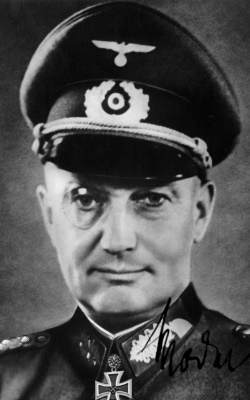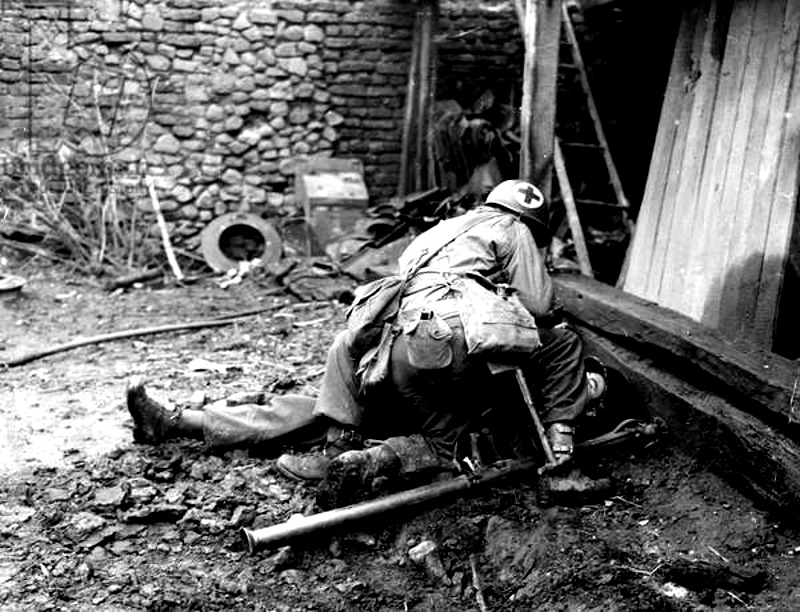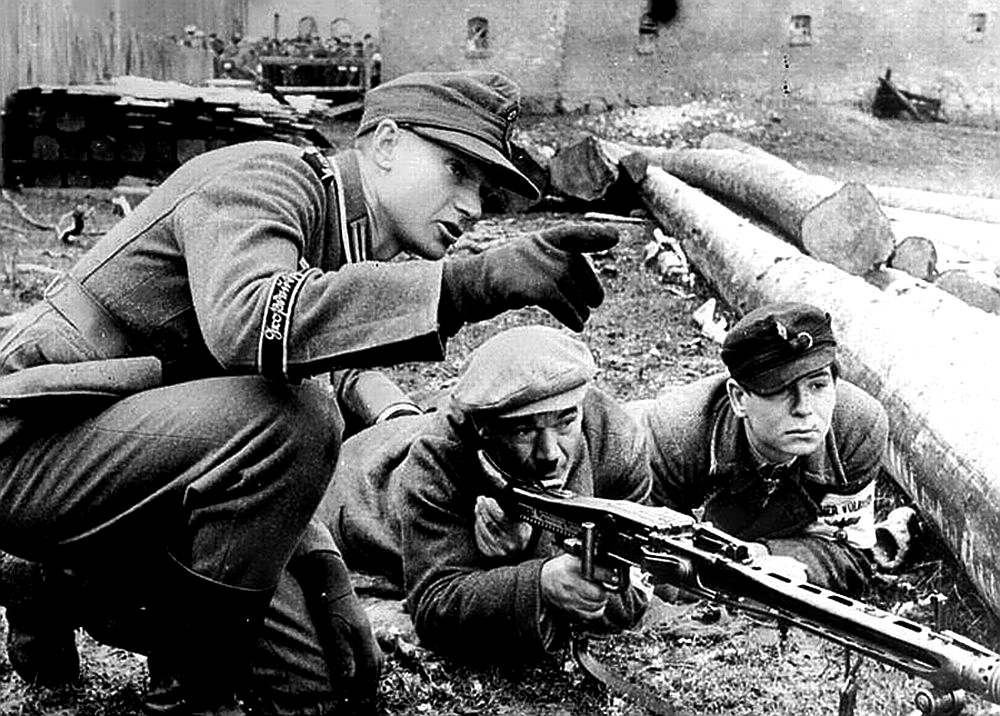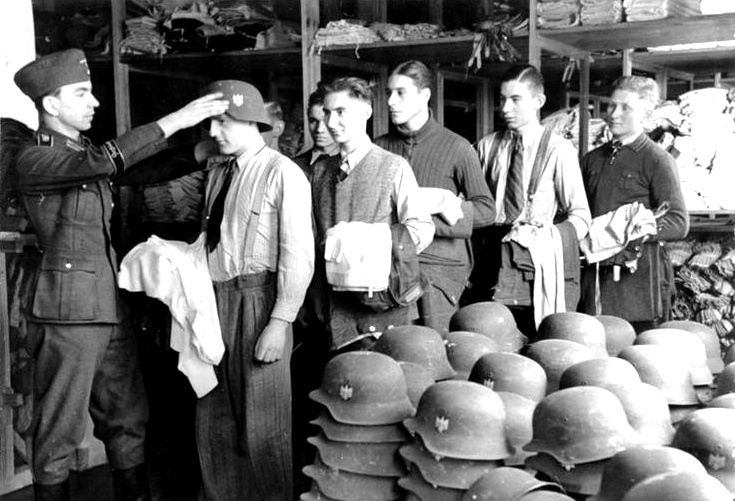The defense in the area consisted of a series of strong points with great gaps in between them. Troops were spread too thin to provide sufficient depth. Nor could the one combat command of the 9-AD be considered sufficient reserve over so large an area. Moreover, in a letter of instructions issued by the US the 1-A on December 6, 1944, the VIII Corps was ‘to continue its previous mission of conducting aggressive defense within the Corps Zone and be prepared to advance on Koblenz on Army order’. The offense was the keynote of the Allied policy and defense was organized only to implement that policy. Thus we find that in the area where the Nazi war machine was to strike on the morning of December 16, 1944, the following order of battle. On the north, in the V Corps sector, the 99-ID and 2-ID attack toward the Roer River dams. On the north flank of the VIII Corps sector filling a small gap lay the 14-CR, attached to the 106-ID which was responsible for the Corps’ left flank. In the center was the 28-ID with CCA/9-AD, while on the south flank the line was occupied by the 4-ID. One combat command of the 9-AD provided the reserve. Three infantry divisions, one armored division, and a reconnaissance unit defended a line of approximately 80 miles in length. Of the divisions, two were recuperating from recent severe losses in the Hurtgen Forest. The third was receiving its battle indoctrination. The reserve lacked battle experience. Thus the stage was set.
The German Plans and Preparations
Behind the West Wall during the critical fall months of 1944, the German High Command also had its problems. Severely defeated in Franoe during the preceding summer months they had, however, salvaged more than was then realized by the Allied High Command. Fighting cores of divisions and armies were in most instances retained. The fact that the German Command avoided a major battle after the Falaise Gap indicates a planned withdrawal. The 7.Panzer-Army, the 15.Panzer-Army and the 5.Panzer-Army by a series of covering actions succeeded in reaching the shelter of the West Wall, the 15.PA in the north facing the British, the 7.PA barring the approach to Cologne, and the 5.PA further south joining with the 1.Army and the 19.Army. True, the Allied pursuit had moved too fast to permit the German Armies to form on one of the many possible defense lines short of the West Wall. But the Allied supply lines, stretched almost to the breaking point slowed the pace of the advancing armies and provided the Germans much-needed time.
September and October were months of extreme activity in reorganization. Drastic measures were needed and drastic measures were taken. An intensive comb-out of German manpower produced an estimated 230.000 men for the defense of the West Wall. Of these 100.000 were used to form fresh divisions, the Volks Grenadiers, 50.000 were used as replacements in battle-depleted divisions, 20.000 were formed into GHQ Troops and 50.000 were members of fortress battalions with some previous training. Many were ‘ersatz’ infantrymen as Luftwaffe and Kriegsmarine personnel were given a few days of infantry training and assigned to combat units.
The fortress battalions, 70 in all, proved a valuable asset. Taken over by the Headquarters of divisions badly mauled in the fighting in France they formed the core of the West Wall defense during the critical period. Remnants of the divisions were then sent to the rear for reorganization and resupply. Fighting from the well-prepared positions they were able to ward off the Allied attacks, thus enabling the Germans to take their depleted Panzer Divisions from the line for reorganization and refitting.
By proclamation, all able-bodied males from 15-60 years of age, in the area between the West Wall and the Rhine, were made available to the army to work on the fortifications. By the opening days of October, the order had been brought out of the chaos in the Rhineland. Faced at last with the defense of the sacred soil of their Homeland the German people had responded to Herr Hitler’s cry ‘Defend to the last man and the last round’. The problem of regaining the initiative lost with the Allied landings in Normandy was Herr Hitler’s greatest concern. Severely injured by the bomb in the attempt on his life on July 20, 1944, and confined to his bed he devoted his time primarily to the military situation. Obsessed with the idea of attack, Hitler in early September, informed FM Wilhelm Keitel, Chief of Wehrmacht High Command, and Gen Alfred Jodl, Chief of the Armed Forces Operation Staff that the initiative was to be regained.
Since the decision had been made to counterattack, the problem remained to select the area. Analyzing the situation on the various fronts on which they were engaged, they arrived at the conclusion that the Western Front offered the best opportunity for decisive results. The Allied supply problem had yet to be solved. Moreover, the Allies were still weak in manpower. Redisposed along the West Wall after the narrow confines of the Normandy perimeter, the lines were thinly held. The Germans were well aware of this situation. Also, Hitler’s contempt for democracies led him to believe that their will to win was weak and that a severe defeat on the Western Front might possibly force them out of the war. It remained for Hitler himself to select the Ardennes Sector for the attack. Learning that only four US divisions defended the area he directed Jodl to submit a detailed plan at the earliest possible date. It was to be a thrust through the Ardennes across the Meuse thence to Antwerp. The port with its communication lines to the southeast toward Liège was to be seized, thereby throttling the British and the US divisions in the north.
In spite of the heavy Allied bombing raids, the Germans had miraculously been able to increase their production in tanks, artillery, and ammunition, chiefly by the expedient of moving their vital plants underground. Their greatest problem was fuel, but by reducing the allowances to other fronts a sufficient quantity was accumulated for the attack. They were weak in the air, and though the Luftwaffe was to concentrate all its available planes to support the attack it must be so timed that the massing of the troops immediately prior to the attack could be done in weather unfavorable to air reconnaissance. Also, the first few days of the attack should have the benefit of weather unfavorable to the Allied Air Force, thus denying them the advantage of their air superiority. The wettest fall and winter in years proved of immeasurable assistance to the Germans particularly in the north where the flooded valleys of the Roer, Waal, and Rhine rivers enabled them to defend with fewer men than would have otherwise been possible. This enabled them to withdraw divisions for reorganization and refitting, and also to give their Volksgrenadier Divisions battle indoctrination under favorable conditions.
The 6.Panzer-Army (SS-Oberstgruppenführer Josef Dietrich) was organized with remnants of panzer divisions withdrawn from the line. In mid-November, it moved from its position deep in Germany to the plains in front of Cologne. There, it served a dual purpose, to counterattack should the Allies succeed in crossing the Roer River and further, to confuse Allied Intelligence as to the role for which it was primarily intended, commitment in the coming attack. The 6.PA was composed of two Corps, the I.SS-Panzer-Korps (SS-Gruppenführer Hermann Preiss) and the II.SS-Panzer-Korps (SS-Obergruppenführer Wilhelm Bittrich), with a total of 4 panzer divisions plus the 180 panzer brigade and elements of the 3.Panzer-Grenadier Division and 2 infantry divisions. Commanded by Sepp Dietrich, a fanatic loyal Nazi, a fact to which he owed his assignment, he lacked the training and experience to command an army.
The preparation of the 5.Panzer-Army (General der Panzertruppe Hasso E. von Manteufell) for its part in the attack was more of a problem. Moved northward in mid-September from positions facing the US 3-A to the Aachen Area it participated in the defense of that city. Withdrawing prior to its surrender, it became a screening force covering the entire area in front of the Ruhr Industrial District. Here began the refitting process, but many of the divisions which were intended for inclusion in the force were committed elsewhere, first east of Aachen, then in Holland, and again in the south, west of the Saar Industrial Area. During the latter part of November, the 15.Army (General der Infanterie Gustav-Adolf von Zangen) moved south to relieve the 5.Panzer-Army which moved further south to Koblenz. Both armies now entered the final weeks of preparation.
Surprise is an essential element in a successful attack. The Germans took elaborate precautions to preserve secrecy. Originally given the code name of ‘Wacht Am Rhein’ in order to deceive Allied Intelligence into believing the projected attack was defensive in character should it become known, it was later changed to a code name more in character ‘Herbstnebel’ (Autumn Smoke). During the early stages of planning only Headquarters Staff officers were aware of its true nature, Hitler’s long-standing mistrust of the high-ranking Army officers was increased by the attempt on his life by a clique that included members of the General Staff. Even FMs Von Rundstedt (CiC West) and Mödel, (CG Army Group B) respectively, were unaware of the projected plans until the latter part of October. As it became necessary that subordinate officers be informed they were forced to sign a pledge of secrecy under the penalty of being shot. Mention of the plans by normal means of communication was forbidden. Only officer couriers were to be trusted with necessary messages and plans. Even they could not fly west of the Rhine. Troop movements west of the Rhine in the build-up were forbidden except at night. During daylight hours all tanks, artillery, and bridging equipment were carefully hidden. The tentative date for the attack was set as November 25. Late in October, FMs Von Rundstedt and Mödel were informed, given the plans of the operation, and ordered to study them thoroughly and submit their views and comments.
Though worked out in minute detail the plan was essentially simple. The 5.Panzer-Army and the 6.Panzer-Army were to make the thrust, the 6.PA on the north advancing with its right flank generally following the line Elsenborn and Spa and to cross the Meuse River at Huy and other points between Huy and Liège, thence to Antwerp. The 5.PA on the south was to advance with its left flank generally on the line Wiltz, Bastogne, St Hubert, Celles and Dinant, force crossings of the Meuse at Dinant and Namur and thence to Brussels and Louvain. On the north flank, the LXVII Corps of the 15.A was to enter the area of penetration on the right flank of the 6.PA then swings north to the northern slopes of the Elsenborn Ridge generally on the line Mutzenich, Verviers, Spa and Liège and block off the area of the heavy concentration of the US 1-A’s divisions. On the south, the 7.A (General der Panzertruppe Erich Brandenberger) was to perform the same function for the 5.PA, forming on a line extending generally from Echternach, to Neufchateau to Givet on the Meuse, guarding against Patton’s divisions further south. Infiltration parties were to seize Meuse River bridges in the vicinity of Huy. A parachute battalion was to be dropped in the vicinity of Eupen to block the Eupen Verviers Malmedy main highway south to Monschau to assist the blocking force. Once the Meuse is crossed the 15.A was to launch an attack toward Maastricht from the northeast. Diversionary attacks were planned toward Antwerp from the north and against the US 7-A and French 1-A in the south.

 After a study of the plans Rundstedt and Mödel suggested that the attack be a double envelopment, the southern thrust to strike in the vicinity of Monschau and swing northward east of Liège. The northern pincer would attack north and east of Maastricht and drive up the Meuse River. The two pincers would join and destroy the US 1-A troops concentrated in the area for the drive on Cologne. Should this not be approved, they then recommended that the attack be planned for the 15.A toward Maastricht be canceled and the troops to be committed there diverted to strengthen the Ardennes thrust.
After a study of the plans Rundstedt and Mödel suggested that the attack be a double envelopment, the southern thrust to strike in the vicinity of Monschau and swing northward east of Liège. The northern pincer would attack north and east of Maastricht and drive up the Meuse River. The two pincers would join and destroy the US 1-A troops concentrated in the area for the drive on Cologne. Should this not be approved, they then recommended that the attack be planned for the 15.A toward Maastricht be canceled and the troops to be committed there diverted to strengthen the Ardennes thrust.
Hitler, backed by Keitel and Jodl, refused to consider the changes recommended. The possible reward was much less than in the original proposal. That the objectives of the Ardennes thrust might be beyond the capabilities of the resources available did not occur to the World War One ex-corporal. The Ardennes attack would be carried out as planned, with Antwerp as the objective. Nothing short of that would satisfy Herr Hitler. Rundstedt, apparently feeling that the plan could never succeed, divorced himself from further efforts other than supply administration relating to the attack. Mödel, however, whose command, Army Group B would bear the responsibility entered enthusiastically into the planning. A well-trained and competent field commander, he was also a loyal Hitler supporter. General der Panzertruppe von Manteuffel, whose 5.PA was to make the southern thrust not so eager. Realizing that unless extreme good fortune was to favor the attack Antwerp was hopelessly out of reach, he accordingly made plans which were to take him only to the Meuse River. He would make further plans if the necessity arose. A competent field commander and a master of armored tactics his advance elements were to reach a point four miles from the Meuse where the river was visible in the distance. One can but speculate on what success might have been achieved with the resources provided for the northern thrust had Manteuffel’s competence been present.
A total of twenty-eight divisions were tentatively allotted. The 6.PA, making the primary thrust was to receive the most generous allotment. Four SS Panzer Divisions plus panzer elements equal to a fifth division, and two infantry divisions were subordinated to the 6.PA for the opening attaok. Manned in excess of its table of organization, and 100% equipped it was well prepared for the jump-off. Manteuffel’s 5.PA did not fare so well. 60 to 80% equipped, his divisions were also understrength. Initially, his army was composed of three panzer divisions and three Volks Grenadier Divisions. Attached to Dietrich 6.PA was the Panzer-Brigade 150. Using US equipment, uniforms, weapons, and insignia it was to pass through the advance elements once St Vith had been reached and move swiftly toward the Meuse River seizing supply installations on the way and creating havoc with rear communications. It was then to seize the Meuse River bridges. Known by the code name of ‘Operation Greif’ though it accomplished nothing tactically it was to have a considerable psychological effect on the Allied forces.























